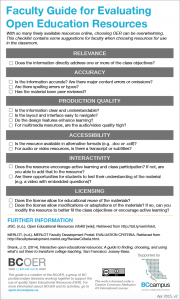Online Educational Content VS. Openly Licensed Educational Content
Today online educational content can be found everywhere and accessed easily through a variety of different technologies (laptops, smartphones, tablets, etc.). Online educational content includes all of the digital learning resources found online. However, not all of this content is openly licensed educational content. Openly licensed educational content specifically refers to educational resources that you can share, use, and in some cases, adapt without asking permission of the original owner or creator (OER Africa, 2020).
OER Example:
An example of an openly licensed online educational resource (OER) is this video, which could be used to explore the topic of bears with a Kindergarten class.
(All Things Animal TV, 2014)
OER Evaluation:
Although this video looks great at first glance, it is important to evaluate it before using it in a learning setting. In order to evaluate this video, I used the following criteria:

Here are my notes on the evaluation of this resource:
- Relevance: This video directly relates to several of the curricular content points in the BC Science Curriculum for Kindergarten (British Columbia Ministry of Education, n.d.).
- Accuracy: The content in this video is all accurate. Furthermore, the video lacks spelling or grammatical errors and is easy to understand for young children. It is unclear if this video has been peer-reviewed; however, the creators All Things Animals TV have a great deal of child-friendly, accurate, animal videos, thus I feel they are a reliable source.
- Production Quality: This video is clear, concise, easy to understand, uses multiple modes of communication (pictures, audio, text, labeling, etc.), and is easy to navigate and access via YouTube.
- Accessibility: This resource only appears to be available in video format; however, you can easily open closed captions and there is a script of the narration included in the description making this video accessible to a wide range of viewers.
- Interactivity: The only interactive element of this video is a movement prompt at the end which asks if you can crawl like a bear. Thus, interactivity is one area that this video could be improved. This could be achieved by editing the video to include some guiding questions and discussion prompts.
- Licensing: This video is licensed with a Creative Commons Attribution License. Thus, you can copy, distribute, display, and even remix this video (OER, 2020), making it ideal for classroom use, especially if I want to edit it!
In general, my review of this resource identified that this video has great potential for use in a classroom, especially if adapted to become more interactive.
OER’s in teaching:
As an educator, OER’s play a large role in my daily life. Although I do create a lot of my own resources when teaching, it can be exhausting to endlessly reinvent the wheel. Thus, it is important that I can find resources that I can freely use and ideally adapt. This cuts down on the amount of work I have to do, while also enabling me to create resources that specifically target the needs of my learners!
References
OER Africa. (2020). What is Open Licensing?. Retrieved from https://www.oerafrica.org/book/what-open-licensing
[All Things Animal TV]. (2014, September 3). * BLACK BEAR * | Animals For Kids | All Things Animal TV [Video File]. Retrieved from https://www.youtube.com/watch?v=5jyFpgIWzsE
British Columbia Ministry of Education. (n.d.). BC’s New Curriculum: Science K. Retrieved from https://curriculum.gov.bc.ca/